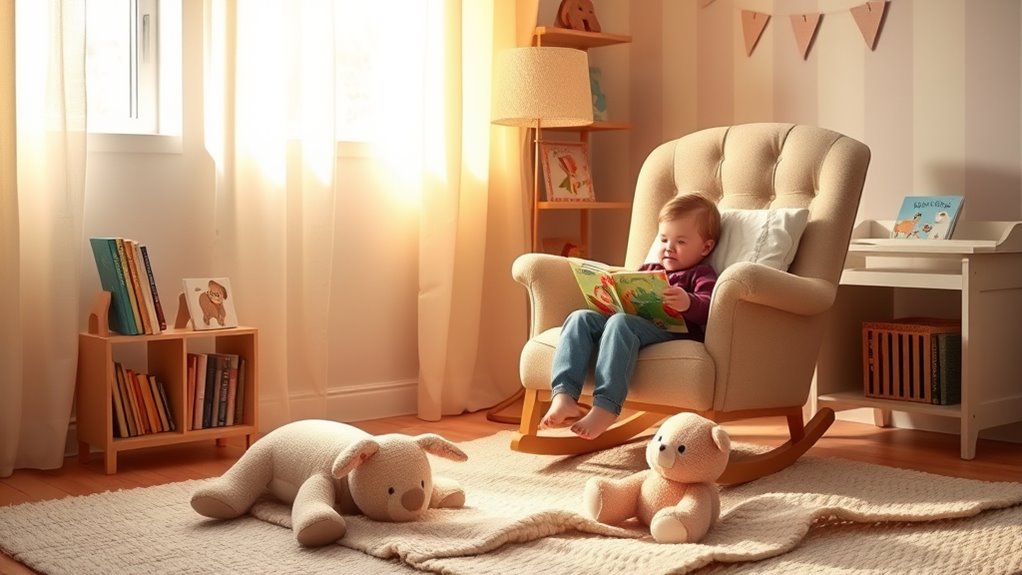To start a bedtime story routine for your toddler, choose a consistent time each evening when your child isn’t overly tired or restless. Create a cozy, calming environment with soft lighting and comfortable seating. Pick age-appropriate, engaging books and involve your child in selecting favorites. Use gentle, expressive storytelling techniques and keep the routine unhurried. Ending with a positive, reassuring note helps your child associate stories with relaxation. Keep exploring to discover more tips for a smooth bedtime shift.
Key Takeaways
- Set a consistent bedtime and routine time to signal it’s time for stories.
- Choose age-appropriate, engaging books with colorful illustrations and simple language.
- Create a cozy, quiet reading environment with soft lighting and comfortable seating.
- Use gentle, expressive storytelling techniques with varied tone and interactive questions.
- Let toddlers select their favorite books or characters to foster interest and participation.
Choose the Right Time for Reading

Choosing the right time for reading is essential to establish a calming bedtime routine. Timing considerations play a pivotal role in helping your toddler associate reading with winding down. Aim to start the story session at the same time each evening to build bedtime consistency. When you keep the routine predictable, your child begins to understand that reading signals the approach of sleep, making it easier to settle down. Avoid rushing or delaying the activity, as irregular timing can create confusion or resistance. Select a time when your toddler isn’t overly tired or restless, ensuring they’re alert enough to enjoy the story. Consistent timing reinforces the routine’s calming effect, helping your child associate reading with relaxation and preparing them for restful sleep each night. Additionally, high refresh rates in a projector can contribute to a more comfortable visual experience during bedtime routines, reducing eye strain and promoting relaxation. Establishing a consistent bedtime can further enhance the effectiveness of your reading routine, creating a reliable cue for sleep.
Select Age-Appropriate and Engaging Books

Selecting books that are suitable for your toddler’s age and interests is essential for fostering a love of reading and ensuring engagement. Focus on storybook themes that resonate with their current experiences, like animals, family, or daily routines. Keep the book length appropriate—short and simple stories work best for young children, holding their attention without overwhelming them. Look for colorful illustrations and age-appropriate language that makes the story lively and easy to understand. Choosing engaging, relatable books helps your toddler connect emotionally and stay interested throughout the story. Avoid overly complex plots or lengthy narratives, as these can lead to frustration. The right books will spark curiosity and set a positive tone for your bedtime routine. Incorporating age-appropriate materials such as tactile or interactive elements can further enhance your child’s engagement and enjoyment.
Create a Cozy and Inviting Reading Nook

Once you’ve picked the perfect books for your toddler, creating a cozy space to enjoy them makes a big difference. Focus on designing a warm, inviting reading environment with soft lighting, comfortable seating, and child-friendly decor. Use plush cushions, blankets, or a small armchair to make the nook appealing and relaxing. Incorporate storytelling props like plush toys, puppets, or picture cards nearby to enhance engagement. These props can turn reading into an interactive experience, encouraging your toddler’s imagination and participation. Keep the area tidy and free of distractions, so your child associates this space with calm, special storytime moments. A well-thought-out reading nook helps foster a love of books and creates a comforting atmosphere for bedtime stories. This setting can also serve as a calm space that signals to your toddler that it’s time to wind down. Additionally, choosing a space that minimizes pollution and noise can help create a more peaceful environment conducive to relaxation and focus.
Set a Consistent Bedtime Routine Schedule

Establishing a consistent bedtime routine schedule helps your toddler know what to expect and signals that it’s time to wind down. Incorporate calming bedtime rituals, like reading a story or singing a lullaby, at the same time each evening. This consistency reinforces a sense of security and helps regulate your child’s sleep patterns. Pay attention to your toddler’s sleep environment by keeping it quiet, dim, and comfortable to promote relaxation. When the routine becomes predictable, your toddler will start to associate specific activities and settings with bedtime, making the progression easier. Stick to the schedule even on weekends to maintain regular sleep cues. Additionally, introducing routine consistency such as encouraging words or affirmations can create a positive atmosphere during bedtime routines, fostering a sense of love and security. Over time, this routine will help your child develop healthy sleep habits and foster a peaceful bedtime experience.
Use Gentle and Expressive Storytelling Techniques

To capture your toddler’s attention, use a soothing voice that feels calm and comforting. Incorporate expressive gestures and change your tone and pitch to make the story more engaging. These techniques help create a warm, inviting atmosphere that makes bedtime stories special. Additionally, maintaining a consistent routine can enhance sleep quality, and incorporating protective styling benefits through gentle storytelling can make the experience even more enjoyable for your child. Using a variety of voices and sound effects can also boost engagement, making the storytime more lively and memorable.
Use Soothing Voice
Using a soothing voice can make a big difference in helping your toddler relax and prepare for sleep. Focus on voice modulation to create gentle rises and falls in your tone, which keeps your storytelling calming and engaging. Adjust your story pacing so that you speak slowly and evenly, giving your child time to absorb each part of the story. A steady, gentle rhythm helps reduce overstimulation and signals that bedtime is near. Keep your voice warm and reassuring, avoiding loud or sudden sounds. This consistent, soothing tone fosters a sense of safety and comfort, making it easier for your toddler to unwind and drift off peacefully. Incorporating hydrocolloid material into your storytelling environment can create a calming atmosphere, as it is known for its soothing, moisture-retentive properties. Additionally, incorporating sleep-promoting behaviors like maintaining a regular routine can enhance your child’s ability to transition smoothly to sleep. Recognizing the importance of credit card security in the digital age underscores how vital it is to create a safe and secure environment, even in bedtime routines. Remember, your calming voice is a powerful tool in establishing a relaxing bedtime routine. Incorporating relaxation techniques into your storytelling can further enhance your child’s sense of calm and readiness for sleep.
Incorporate Expressive Gestures
Incorporating gentle and expressive gestures into your storytelling can considerably enhance your toddler’s engagement and emotional connection to the story. Use gestural expressions to highlight key moments, making the story feel more vivid and memorable. Animated gestures, like waving, pointing, or miming actions, help bring characters and scenes to life. When you read, match your gestures to the story’s tone—soft and slow for calming parts, lively and exaggerated for exciting scenes. This physical involvement captures your toddler’s attention and encourages them to participate. Keep your movements natural and gentle, ensuring they complement your voice and storytelling style. By integrating expressive gestures, you make the story more immersive and foster a stronger emotional bond during your bedtime routine. Additionally, practicing mindful decluttering strategies can help create a calm and organized environment that enhances your storytelling experience. Incorporating visual cues such as pictures or props can further support your expressive gestures and keep your toddler engaged throughout the story. Understanding the importance of website privacy policies can also help ensure that your online resources or digital storytelling tools are used safely and responsibly. Engaging in interactive storytelling techniques can further deepen your child’s interest and participation.
Vary Tone and Pitch
Varying your tone and pitch while telling a bedtime story keeps your toddler engaged and helps convey different emotions and moods. Use voice modulation to emphasize key moments and bring characters to life. Tone variation allows you to express excitement, tenderness, or curiosity, making the story more engaging. When you change your pitch, you signal shifts in the story’s mood, helping your toddler follow along and understand the narrative better. Speak softly during calming parts and elevate your voice during exciting scenes. This dynamic storytelling technique not only maintains interest but also encourages your child’s emotional development. Remember, the key is to be expressive and intentional with your voice, making the storytime both soothing and stimulating.
Incorporate Interactive Elements and Questions

Adding interactive elements and questions to your bedtime story routine can make the experience more engaging and memorable for your toddler. Use interactive questions to encourage your child’s participation and thinking, such as asking, “What do you think happens next?” or “Can you find the animal’s tail?” Incorporate storytelling techniques like changing your tone or using expressive gestures to bring the story to life. These strategies help your toddler stay involved, develop language skills, and build a deeper connection with the story. By making questions a natural part of storytelling, you transform a simple read-aloud into an interactive adventure. Keep questions simple and fun, and let your child’s curiosity guide the conversation.
Make Storytime a Calm and Unhurried Experience

Creating a calm and unhurried storytime helps your toddler relax and enjoy the moment. You can set a soothing atmosphere with soft lighting and quiet surroundings, making it easier for your child to focus. Establishing a consistent routine signals that it’s time to wind down, fostering a peaceful bedtime experience.
Set a Relaxing Atmosphere
To help your toddler relax and enjoy storytime, it’s important to set a calm and unhurried atmosphere. Choose a cozy spot with soft lighting and minimal distractions to create a soothing reading environment. Select calming books with gentle colors and simple stories to keep your child engaged without overstimulation. Use a table to visualize key elements:
| Book Selection | Reading Environment |
|---|---|
| Gentle, soothing stories | Dim lighting and soft music |
| Short, engaging books | Quiet, cozy space |
| Age-appropriate content | Comfortable seating |
| Repetitive phrases | Minimal noise |
| Positive themes | Warm blankets or pillows |
This setup helps your toddler associate storytime with relaxation, making it a peaceful, enjoyable routine.
Establish a Consistent Routine
Establishing a consistent routine helps your toddler know what to expect during storytime, making it a more calming and unhurried experience. When you stick to regular bedtime stories, your child begins to associate specific cues with winding down, which reduces anxiety and promotes relaxation. Create a predictable schedule by reading at the same time each evening and using familiar books. This consistency reinforces your reading routines, helping your toddler feel secure and comfortable. Keep storytime simple and unhurried, focusing on the present moment rather than rushing through pages. Over time, your child will anticipate these calming moments, easing into sleep more easily. A steady routine turns bedtime stories into a comforting ritual that supports your toddler’s emotional and sleep habits.
Involve Your Toddler in Choosing Books

Involving your toddler in choosing books makes bedtime stories more engaging and helps foster their love of reading. When they select books featuring favorite characters or storytelling themes they enjoy, bedtime becomes something they look forward to. Encourage them to pick from a small selection, making the process fun and interactive. Use the following table to guide choices and add rhythm to your routine:
| Favorite Characters | Storytelling Themes |
|---|---|
| Mickey Mouse | Friendship and Adventure |
| Curious George | Problem-solving |
| Peppa Pig | Family and Daily Life |
This way, your toddler feels empowered and excited, making storytime a personalized experience that nurtures their curiosity and interests.
Establish a Positive and Reassuring End to the Session

Ending your bedtime story session on a positive and reassuring note helps your toddler feel safe and calm as they prepare for sleep. Use positive reinforcement by praising their listening and participation, which encourages a sense of achievement and comfort. Offer emotional reassurance by speaking softly and using gentle touch or cuddles to reinforce feelings of security. Summarize the story with a warm comment or a favorite part to leave a joyful impression. Avoid rushing through the ending; instead, take a moment to connect emotionally. This positive closure helps your child associate bedtime with comfort and safety, easing their *progression* to sleep. Consistently ending on a reassuring note builds trust and creates a peaceful bedtime routine your toddler will look forward to.
Frequently Asked Questions
How Can I Make Storytime More Enjoyable for My Toddler?
To make storytime more enjoyable, try incorporating interactive storytelling where your toddler can participate by asking questions or making sounds. Use visual aids like colorful pictures or stuffed animals to bring the story to life, keeping their interest high. You can also let your toddler choose the story or hold the book, making the experience engaging and fun. These techniques help foster a love for stories and create happy bedtime memories.
What Are Signs My Toddler Is Ready for a Bedtime Story Routine?
You’ll notice signs of readiness like your toddler becoming more interested in books or wanting you nearby during quiet times. Bedtime cues such as rubbing eyes, yawning, or fussiness also indicate they’re tired. When your toddler consistently shows these signs, it’s a good time to introduce a bedtime story routine. Responding to these cues helps create a calm, predictable environment, making storytime enjoyable and establishing a gentle sleep passage.
How Do I Handle Toddler Resistance or Tantrums During Storytime?
When your toddler resists or throws tantrums during storytime, stay calm and patient. Use positive reinforcement by praising their cooperation and offering gentle boundaries, like a consistent routine or special cuddles. Keep storytime engaging with lively voices or favorite books. If resistance continues, take a short break and try again later. Consistency and gentle guidance help your toddler feel secure, making storytime a positive experience over time.
What if My Toddler Loses Interest Quickly in Stories?
Losing interest quickly can feel like your toddler’s attention span is a lightning bolt! To keep them engaged, try interactive storytelling—ask questions, use expressive voices, or incorporate their favorite characters. Always choose engaging books with colorful pictures and simple, rhythmic text. If they drift away, switch to a different story or make it more playful. The key is to make storytime fun and tailored to their interests, so they’ll look forward to it every night.
How Can I Adapt Storytime for Toddlers With Sensory Sensitivities?
You can adapt storytime for sensory-sensitive toddlers by choosing sensory-friendly books with soft textures or gentle sounds. Incorporate calming sensory activities, like gentle rocking or deep breathing, before reading. Keep story sessions short and engaging, using expressive voice and slow pacing. This approach helps your toddler feel comfortable and focused, making bedtime a soothing, enjoyable experience for their sensory needs.
Conclusion
By choosing the right time, selecting engaging books, and creating a cozy space, you set the stage for a calming routine. By setting a consistent schedule, using expressive storytelling, and involving your toddler, you build connection and comfort. By making storytime calm, making it interactive, and ending positively, you foster a love for reading. Follow these steps to make bedtime stories a cherished, peaceful part of your toddler’s nightly routine, creating memories that last.










